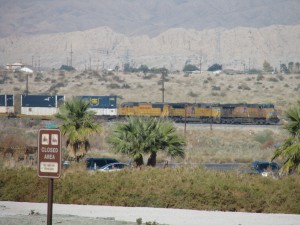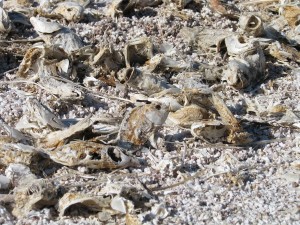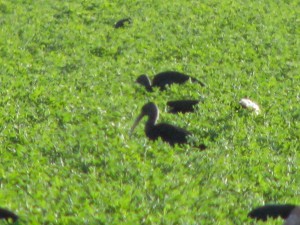Salton Sea

Salton Sea is a terminal sea, created by accident in 1905 by a break in an irrigation canal from the Colorado River.

Salty and as it evaporates, becoming saltier, the sea hosts water sports, camping, and in the summer black flies by the millions, temperatures well over 100F, and the smell of rotting fish. However it is also one of the birding hotspots of the United States, as it is located along the Pacific Flyway in the Imperial Valley.

My daughter and I took advantage of the cooler post-Christmas weather and drove there last week. Winter is the best time to see birds and we weren’t disappointed.

The drive was a little over two and a half hours from our home, skirting the mountains and into the desert communities.The Sea is about 35 miles long, and is about 227 feet below sea level. The north-west part of Salton Sea hosts the visitor’s center and some good birding areas, but the best areas for us were about thirty miles south (it isn’t called a sea for nothing!) at the Sonny Bono Salton Sea National Wildlife Refuge, Unit #1.

Fish die-off is a sad part of the life cycle of the mineral-heavy sea, and the sand is layered with the decomposing bones of millions of fish.

Thousands of birds in enormous flocks can be seen all around the Sea. It is a grand thing to witness; it had been a common sight until fairly recently in US history to have flocks of birds so dense they blacken the sky.

There weren’t that many there, but the numbers were amazing. In the southern part are agricultural fields where we saw hundreds of curlews and ibises feeding between the crops.

We were looking in particular for burrowing owls, and the advice we were puzzled to receive was to look in irrigation ditches and pipes along the road. Then, sure enough, as we were driving my daughter suddenly caught sight of one sitting alongside the road at the top of an irrigation ditch! He obligingly posed for many photographs. Later I saw two sitting at the opening of a pipe that protruded from an irrigation ditch! Amazing.

One of the highlights for me was seeing sandhill cranes. These beautiful and majestic birds were feeding in ponds adjacent to flocks of pelicans. I didn’t happen to get any photos of them although my daughter did, because I was busy crawling under the car trying to find the source of the intense squealing sound that suddenly developed (only gravel in the wheel, thank goodness!) There were also hundreds of snow geese, and long strings of hundreds of red-winged blackbirds filled the sky as the sun set.

We left, entranced, at sunset, and took the route home through the Anza-Borrego desert, up to 4,000 feet above sea level through the mountain town of Julian and back to Fallbrook in just over 2 1/2 hours. We covered about 275 miles that day, but it was well worth it for birding. The visitor’s center has many pamphlets on other birding areas in the vicinity, but they’d have to be done on other trips because there are just too many birds to see in one day!

Other birds we saw included Bonaparte’s gull, American Avocets, Stilt Sandpiper, Long-billed Dowitcher, and Gambel’s Quail, to name a few. An excellent birding site with Salton Sea bird list and locations is htttp://southwestbirders.com. Search for Salton Sea.
